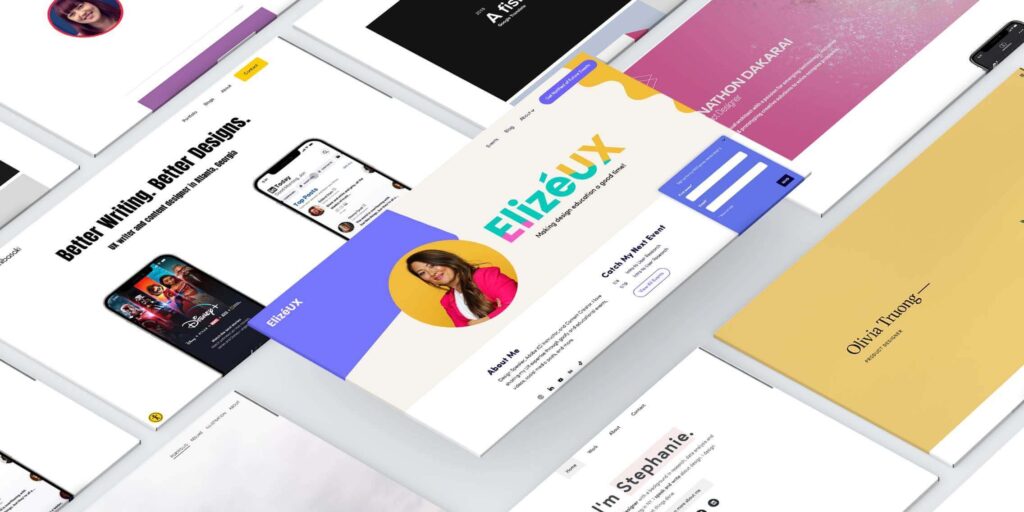Creating a compelling UX portfolio is essential for showcasing your skills and standing out in the competitive field of user experience design. In this blog, we’ll explore 15 of the best UX portfolios and delve into what makes them exceptional. Whether you’re a seasoned designer or just starting, there’s a lot to learn from these standout examples.
Introduction
In the world of UX design, a well-crafted portfolio is more than just a collection of your work—it’s a powerful tool to demonstrate your design thinking, problem-solving abilities, and creative flair. A top-notch UX portfolio not only highlights your skills but also tells a story about your design journey. So, what makes a UX portfolio truly great? Let’s dive into 15 impressive portfolios and discover the lessons they hold.
1. Tiffany K. – The Storyteller
Tiffany K.’s portfolio stands out for its narrative-driven approach. Each project is presented as a story, detailing the problem, the process, and the solution.
- Lesson: Emphasize storytelling in your UX portfolio. Use engaging narratives to describe your design process and outcomes.
- Key Feature: Clean layout with engaging visuals and project stories.
2. Dan Mall – The Designer’s Designer
Dan Mall uses his portfolio to highlight not just his work but his philosophy and approach to design.
- Lesson: Share your design philosophy and process. Let potential clients or employers understand how you think and approach problems.
- Key Feature: In-depth case studies and a focus on design thinking.
3. Jessica Walsh – The Visual Maestro
Jessica Walsh’s portfolio is a visual treat, featuring bold designs and a distinctive style that makes her work instantly recognizable.
- Lesson: Ensure your portfolio reflects your personal style. Use visuals to make a strong impression.
- Key Feature: Striking visuals and a unique personal brand.
4. Chris Biron – The Minimalist
Chris Biron employs a minimalist design for his portfolio, focusing on simplicity and clarity.
- Lesson: Sometimes less is more. A minimalist design can help your work stand out without distractions.
- Key Feature: Simple design and easy navigation.
5. Nina T. – The UX Researcher
Nina T. showcases her UX research skills prominently, including detailed case studies and research findings.
- Lesson: Highlight your research skills and methods. Show how your research impacts your design decisions.
- Key Feature: Detailed case studies and research insights.
6. Tommy Li – The Interactive Experience
Tommy Li integrates interactive elements into his portfolio, offering a hands-on experience of his design skills.
- Lesson: Consider adding interactive elements to your portfolio to engage visitors.
- Key Feature: Interactive design elements and engaging user experience.
7. Sarah F. – The Multi-Disciplinary Designer
Sarah F. showcases her versatility by including a variety of projects from different design disciplines.
- Lesson: Demonstrate your range of skills. A diverse portfolio can show your adaptability and breadth.
- Key Feature: Varied projects across multiple design areas.
8. David Lee – The Problem Solver
David Lee focuses on solving real-world problems with his design solutions, providing a clear narrative of his approach.
- Lesson: Frame your projects around problem-solving. Show how your designs address specific challenges.
- Key Feature: Problem-focused case studies and solutions.
9. Emma R. – The User-Centric Designer
Emma R. highlights her commitment to user-centric design with detailed user personas and journey maps.
- Lesson: Showcase your user-centric approach. Include user research and personas to illustrate your design process.
- Key Feature: Emphasis on user personas and journey mapping.
10. Alex J. – The Brand Alchemist
Alex J. merges UX design with branding, offering insights into how design can enhance brand identity.
- Lesson: Combine UX design with branding. Show how your work contributes to a brand’s identity and goals.
- Key Feature: Integration of UX design with branding elements.
11. Olivia W. – The Data-Driven Designer
Olivia W. incorporates data and analytics into her portfolio, demonstrating how she uses data to drive design decisions.
- Lesson: Use data to support your design decisions. Show how data analysis influences your work.
- Key Feature: Data-driven design insights and analytics.
12. Ethan K. – The Experience Curator
Ethan K. focuses on creating seamless user experiences, with a portfolio that showcases his attention to detail.
- Lesson: Highlight your focus on user experience. Show how your designs create a seamless user journey.
- Key Feature: Detailed user experience case studies and attention to detail.
13. Maya P. – The Visual Storyteller
Maya P. uses rich visuals and animations to tell the story of her design projects.
- Lesson: Leverage visuals and animations to enhance your storytelling. Make your portfolio engaging and dynamic.
- Key Feature: Rich visuals and animated project showcases.
14. Lucas H. – The Collaborative Designer
Lucas H. emphasizes his collaborative work with other designers and stakeholders, showcasing team projects.
- Lesson: Show your ability to work collaboratively. Highlight team projects and your role in them.
- Key Feature: Collaborative projects and teamwork highlights.
15. Sophia M. – The UX Innovator
Sophia M. focuses on innovative solutions and cutting-edge design trends in her portfolio.
- Lesson: Showcase your innovation and trend-awareness. Demonstrate how you incorporate the latest trends into your designs.
- Key Feature: Innovative design solutions and trend integration.
FAQs
Q: What should be included in a UX portfolio?
A: A UX portfolio should include a variety of projects showcasing your design process, problem-solving skills, and the impact of your work. Include case studies, user research, wireframes, prototypes, and final designs.
Q: How many projects should I include in my UX portfolio?
A: Aim for 3-5 high-quality projects. Focus on showcasing your best work and providing detailed case studies for each project.
Q: How can I make my UX portfolio stand out?
A: To make your UX portfolio stand out, focus on storytelling, use engaging visuals, highlight your unique design process, and show how you address real-world problems. Personalize your portfolio to reflect your design style and philosophy.
Q: Should I include personal projects in my UX portfolio?
A: Yes, personal projects can demonstrate your passion and skills. Include them if they showcase your abilities and creativity effectively.
Q: How often should I update my UX portfolio?
A: Update your UX portfolio regularly to include new projects and reflect your current skills and experience. Aim to review and refresh it every few months or whenever you complete significant new work.
Conclusion
Crafting a remarkable UX portfolio involves more than just showcasing your work—it’s about presenting your design journey and process in a way that captivates and engages. By learning from these 15 outstanding UX portfolios, you can gather insights on how to refine your own portfolio and make it a powerful tool for your career advancement. Remember, your UX portfolio is a reflection of your skills, creativity, and approach to design—make it count!







